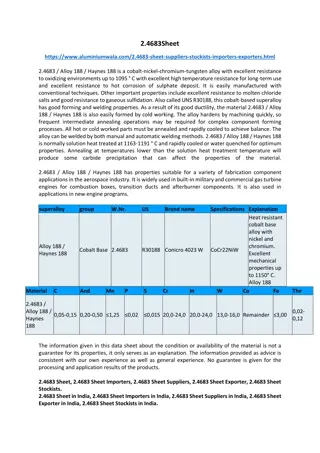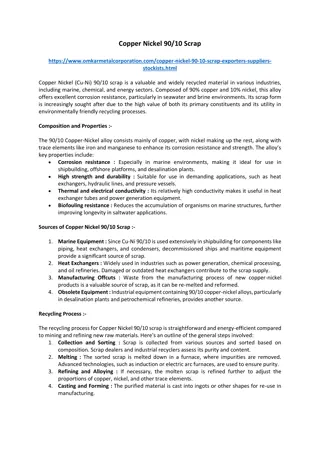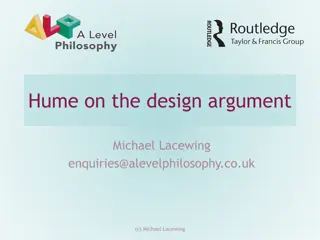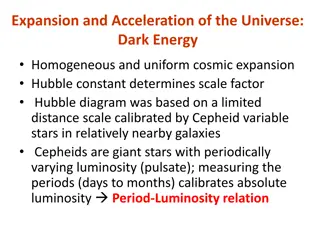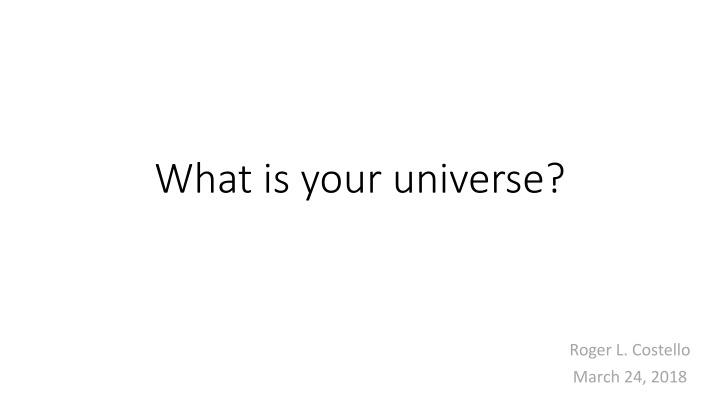
Exploring Different Universes and Their Significance
Delve into the concepts of various universes, from Euclid's plane assumption to non-Euclidean geometries like Lovachevsky and J. Bolyai's circular universe. Discover how different perspectives influence our understanding of parallelism and the implications for Alloy modeling.
Download Presentation

Please find below an Image/Link to download the presentation.
The content on the website is provided AS IS for your information and personal use only. It may not be sold, licensed, or shared on other websites without obtaining consent from the author. If you encounter any issues during the download, it is possible that the publisher has removed the file from their server.
You are allowed to download the files provided on this website for personal or commercial use, subject to the condition that they are used lawfully. All files are the property of their respective owners.
The content on the website is provided AS IS for your information and personal use only. It may not be sold, licensed, or shared on other websites without obtaining consent from the author.
E N D
Presentation Transcript
What is your universe? Roger L. Costello March 24, 2018
Written in ancient Greece by a fellow named Euclid, Elements is widely considered one of the most important books ever written.
Build from a small set of axioms The book starts with a small set of statements (called axioms) that Euclid (and others) considered to be self-evident. From these axioms he derived a great many statements that were known to be true about geometrical figures. In this way he systematized the field of geometry (now known as Euclidean Geometry).
Here is one of the axioms Parallel Postulate: Given a line L and a point P not on L, one and only one line L can be drawn through P parallel to the line L (i.e., not intersecting no matter how far extended). That makes sense, right? Pretty obvious, right?
But what is Euclid assuming? Answer: He is assuming a plane, that goes on indefinitely. That is Euclid s universe.
There are other ways to view the universe In the 19th century N. Lovachevsky and J. Bolyai decided to use a different universe. Their universe was a circle. In the circle they drew a line L from one side to the other and a point P not on the line: How many lines are parallel to L? That is, how many lines go through P without intersecting L?
Answer: lots of lines! Here are two such lines: In this universe there can be many parallel lines. Starting with this universe, Lovachevsky and J. Bolyai derived many other things. This became known as non-Euclidean geometry.
What does this have to do with Alloy? When you create an Alloy model, what is your universe? Answer: your universe is finite, it is comprised of the atoms in the signatures in your model. The keyword univ returns all the atoms in the universe (that is, all the atoms in your model s signatures). Here is an Alloy model, what is its universe? sig A { field1: B, field2: C } sig B {} sig C {}
The univ univ keyword The Alloy Analyzer generates instances. Each instance may contain different numbers of atoms for each signature. I ran the model on the previous slide and for one instance, univ has this: sig A { field1: B, field2: C } univ = {A0, A1, B0, B1, C0, C1} sig B {} sig C {}
pred pred with univ univ arguments The following is a pred that has two arguments: (1) a set of values from the universe and (2) a set of pairs (x, y) where x and y are values from the universe. // Given a set A and a relation R in A, R is transitive // if and only if for all ordered pairs (x, y) and (y, z) in R, // the pair (x, z) is also in R. pred transitive (A: setuniv, R: univ->univ) { all x, y, z: A | (((x ->y) in R) and ((y -> z) in R)) => ((x -> z) in R) }
The iden iden keyword In addition to the keyword univ, there is another important keyword, iden. It is the set of (x, x) pairs for all the values in the universe, e.g., iden = {A0->A0, A1->A1, B0->B0, B1->B1, C0->C0, C1->C1} Do Lab5

![textbook$ What Your Heart Needs for the Hard Days 52 Encouraging Truths to Hold On To [R.A.R]](/thumb/9838/textbook-what-your-heart-needs-for-the-hard-days-52-encouraging-truths-to-hold-on-to-r-a-r.jpg)
![Read⚡ebook✔[PDF] Life in the Universe: Expectations and Constraints (Springer P](/thumb/21626/read-ebook-pdf-life-in-the-universe-expectations-and-constraints-springer-p.jpg)











